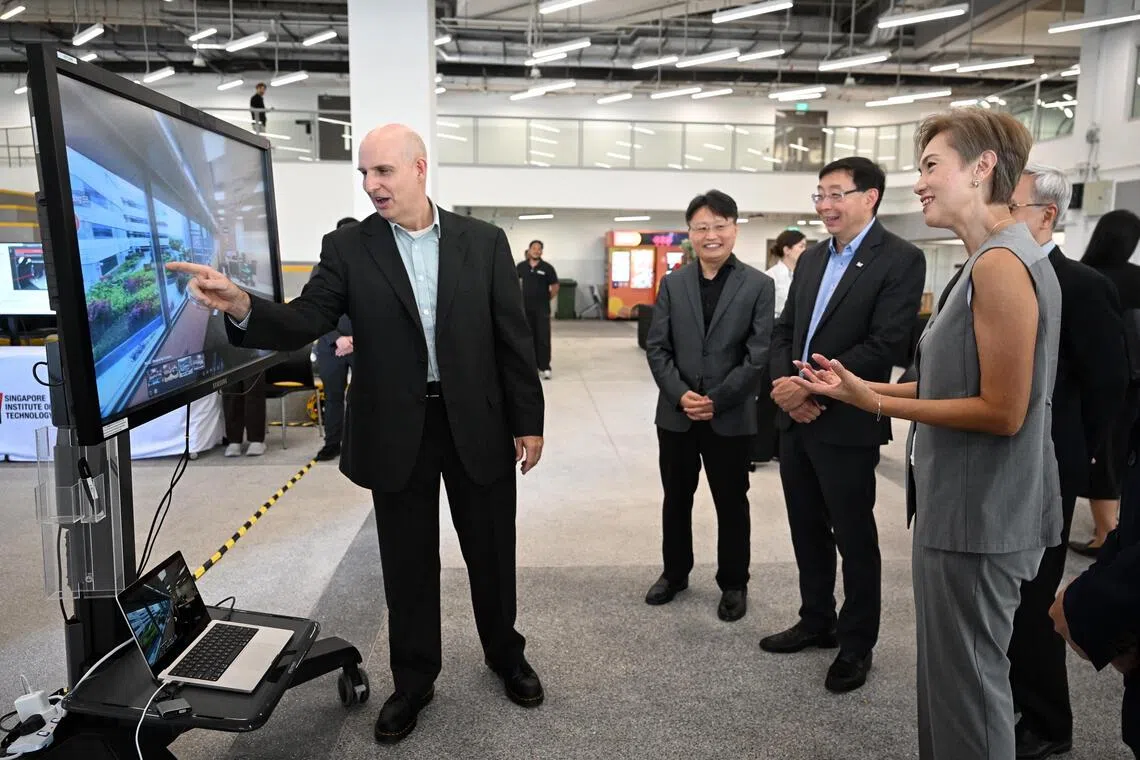SIT’s new AI programme to train 200 practitioners in 3 years
Sign up now: Get ST's newsletters delivered to your inbox

Minister for Digital Development and Information Josephine Teo being taken on a virtual tour of the SIT x Nvidia AI Centre by Professor Ian McLoughlin from the Singapore Institute of Technology at the official opening of the centre on Oct 2.
ST PHOTO: CHONG JUN LIANG
Follow topic:
SINGAPORE – A new six-month artificial intelligence (AI) programme, which aims to train more than 200 fresh graduates and mid-career professionals over the next three years to become AI practitioners, was launched at the Singapore Institute of Technology (SIT) on Oct 2.
To complement the programme, SIT also unveiled an Applied AI Doctoral Training Centre, which creates a development pathway from AI practitioners to applied AI researchers and innovators.
The AI programme was launched during the official opening of the SIT x Nvidia AI Centre (SNAIC), a collaboration between the university and chipmaking giant Nvidia that conducts applied AI research.
Since its inception 1½ years ago, SNAIC has worked with 70 companies to develop 50 AI solutions across the manufacturing, healthcare and transport sectors.
The new training initiative, called SNAIC AI Programme, was developed in collaboration with the Infocomm Media Development Authority.
It aims to equip professionals with the skills to leverage AI tools, libraries and algorithms to develop AI applications.
The programme includes a two-month-long intensive training that is based on modules developed by SNAIC, equipping professionals with the latest AI skills and tools in generative AI, large language models and agentic AI, which refers to AI systems designed to make autonomous decisions.
Participants will spend four months on projects with industry partners to solve real-world business problems with AI. They will be supervised by instructors and experts from SIT and SNAIC.
The programme costs $1,000 before GST, and is open to applicants with foundational skills in Python, cloud platforms and data technologies, as well as a degree or diploma in computing, engineering or related fields.
Speaking to the media, Professor Susanna Leong, vice-president for applied research at SIT, said: “We also hope to be able to train SIT’s accountancy, allied health and engineering students to be fluent in AI, so that, in their respective domains, they can use AI productively... and contribute to their company’s competitiveness.”
The training programme is part of efforts to expand Singapore’s pool of AI practitioners to 15,000
During the launch at SIT’s Punggol campus, Minister for Digital Development and Information Josephine Teo said building up Singapore’s pool of AI practitioners will help ensure that tools are deployed in collaboration with humans, rather than solely pursuing every last bit of performance improvement.
She cited a study published by Massachusetts Institute of Technology researchers in April 2024, which found that when radiologists used an AI diagnostic tool, the accuracy of their diagnoses actually declined, even though the tool alone outperformed two-thirds of radiologists.
This was because the tool was not designed for collaboration with human experts, and offered little transparency about its reasoning, leading radiologists to suspend their better judgment.
Mrs Teo said that while AI can sometimes automate tasks performed by humans with little or no loss of value, Singapore must exercise caution in its use of it.
“In some instances, the AI is not good enough, and chasing the last bit of performance of the AI just to replace a human being makes no sense. We should instead... discipline ourselves to think of using AI to collaborate with humans and let the two work together as one,” she said.
To do this, Singapore needs to grow its pool of AI practitioners to include not only experts in building AI, but also domain experts like radiologists, technicians and lawyers who know how to apply AI in their fields, said Mrs Teo.
Calling these people “AI bilingualists”
The new centre will anchor all of SIT’s applied AI doctoral projects.
SNAIC will support the centre in training 10 industrial doctorate students annually, focusing on complex, industry-driven challenges.

Since its inception 1½ years ago, the SIT x Nvidia AI Centre has worked with 70 companies to develop 50 AI solutions across manufacturing, healthcare and transport sectors.
ST PHOTO: CHONG JUN LIANG
Candidates will undertake multi-year research projects that cannot be solved with off-the-shelf tools.
The industrial doctorate complements the SNAIC AI programme, creating a tiered talent development pathway from being practitioners to becoming applied AI researchers and innovators.
Mrs Teo said this is the first of several planned doctoral training centres that will provide Singaporeans who are already domain experts with the chance to be experts in applying AI to solve real-world problems.
Subsequent centres will focus on developing more “AI bilingualists” who can contribute to AI innovation in Singapore’s priority sectors, such as maritime and healthcare, she added.


